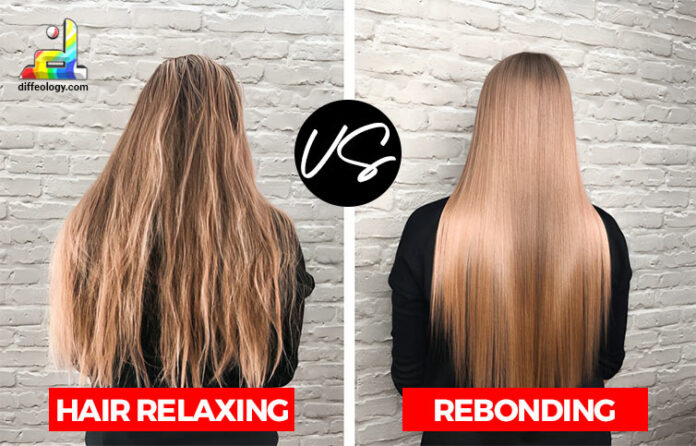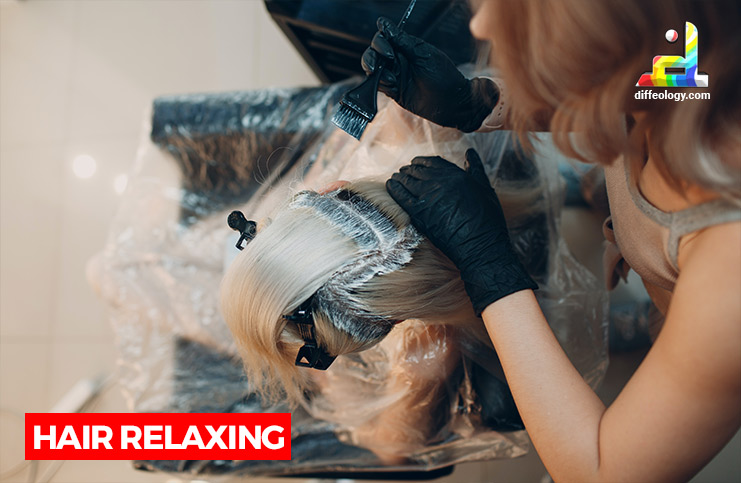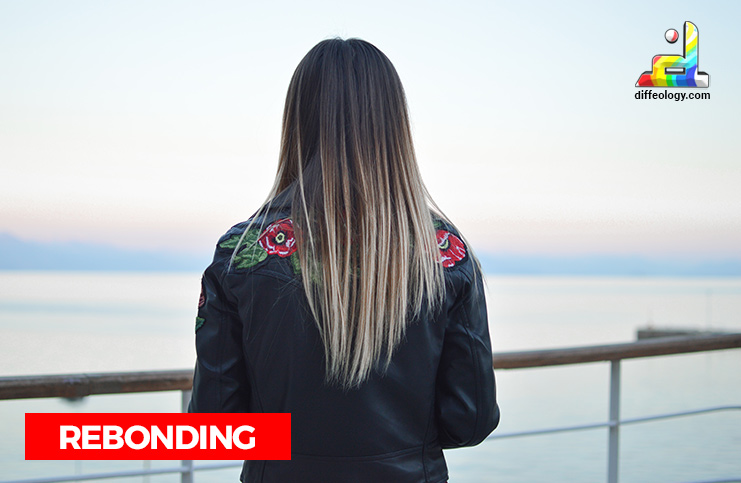Hey there, have you ever wondered why some people have straight, sleek hair while others have those cool curls or waves? Well, it’s all about how their hair is treated. You might have heard about hair relaxing and rebonding, but what exactly are they, and what sets them apart? Let’s break it down in a way that’s easy to understand the Difference Between Hair Relaxing and Rebonding.
First off, imagine your hair like a bunch of tiny springs. Hair relaxing is like loosening those springs a bit to make them less curly or wavy. It involves using chemicals to relax the natural curl pattern of the hair, giving it a smoother and straighter appearance. On the other hand, rebonding is like completely reshaping those springs. It’s a more intense process where the hair is chemically straightened and then set into a new straight structure, making it super sleek and shiny. So, while both methods aim for straighter hair, they differ in how they achieve that result.
The Main Difference Between Hair Relaxing and Rebonding
Hair relaxing aims to soften curls and reduce frizz for a more manageable look. Hair rebonding aims to completely straighten hair, eliminating curls and waves. Hair relaxing uses mild chemicals to loosen curls without altering the hair’s structure drastically. Hair rebonding involves stronger chemicals that break down hair bonds, resulting in a permanent change in texture.
Hair Relaxing Vs. Rebonding
What is Hair Relaxing?
Hair relaxing is like giving your hair a super chill pill. Imagine your hair being all curly or frizzy, and you want it to be straight and smooth instead. That’s where hair relaxing comes in. It’s like a magic potion for your hair, making it relax and lay down flat.
Read Also: Difference Between Toboggan Hat and Beanie
Here’s how it works: a special cream or lotion is applied to your hair, which breaks down the natural curls or waves. This cream softens the bonds in your hair, making them flexible enough to be reshaped. Then, your hair is straightened using a comb or special tool. After a while, voila! Your hair is transformed into silky smoothness. It’s like hitting the pause button on your hair’s natural texture and giving it a whole new vibe.
What is Hair Rebonding?
Hair rebonding is like giving your hair a makeover from curly or wavy to super straight. It’s like pressing the reset button on your hair’s texture. Here’s the lowdown: a special chemical treatment is applied to your hair, which breaks down the natural bonds that give your hair its shape. This treatment softens your hair, making it flexible enough to be reshaped. Then, your hair is straightened using a flat iron, locking in that sleek, straight look. After the treatment, your hair stays straight for a long time, giving you that cool, smooth style you’ve always wanted.
Read Also: Difference Between Tuxedo and Suit
Think of it as giving your hair a new identity. It’s like transforming a wild lion’s mane into a smooth, tamed lion’s fur. With hair rebonding, you can change up your look and rock that straight, sleek style effortlessly. It’s like hitting the refresh button on your hair, making it look fresh and cool.
Comparison Table “Hair Relaxing Vs. Rebonding”
| Definition | Chemical process to loosen curls or waves | Chemical process to permanently straighten hair |
| Result | Achieves a softer, looser texture | Produces straight, sleek hair |
| Chemicals Used | Typically uses mild chemicals like ammonium thioglycolate | Utilizes strong chemicals like keratin or sodium hydroxide |
| Process Duration | Generally takes around 1-2 hours | Typically requires 3-4 hours or more |
| Hair Type Suitability | Suitable for curly or wavy hair types | Suitable for curly, wavy, or frizzy hair |
| Maintenance | Requires touch-ups every few months | Requires minimal maintenance, may last up to a year |
| Damage Potential | Can cause damage if not properly applied or if hair is over-processed | Can be damaging if not done correctly or excessively |
| Hair Texture After | Hair may become slightly drier or frizzy | Hair usually becomes smoother and shinier |
| Hair Health | Can maintain some natural volume and movement | Results in very straight hair with reduced volume |
| Cost | Generally less expensive compared to rebonding | Usually more expensive due to the intensive process |
| Versatility | Offers more styling options due to retained texture | Limits styling options due to straightened nature |
| Longevity | Results may last for a few months | Results are semi-permanent, lasting several months to a year |
| Risk of Breakage | Lower risk compared to rebonding | Higher risk due to the intensive process |
| Professional Skill | Requires skilled application to avoid damage or uneven results | Demands expertise to achieve desired straightness and minimize damage |
Difference Between Hair Relaxing and Rebonding in Detail
Purpose
So, hair relaxing and rebonding might sound similar, but they’re kinda like different superheroes with different powers. Hair relaxing is like when you wanna make your hair a bit less curly or wavy so it’s easier to handle. It’s like taming a wild beast, making it more obedient. But rebonding, that’s like Hulk straightening – it’s hardcore, making your hair super straight, no messing around.
Chemical Process
Okay, so picture this – hair relaxing uses special chemicals called relaxers to break down the curls in your hair. It’s like using a secret formula to unlock those twists and turns. But rebonding is like a double whammy. First, it breaks the bonds in your hair to make it all loosey-goosey, and then it reforms them to keep your hair straight, almost like a magic spell.
Duration and Results
Think of hair relaxing as a temporary fix, like putting a band-aid on a scratch. It lasts for a few weeks or months, but then you gotta do it again as your hair grows. Rebonding, though, is more like getting a tattoo – it’s there for the long haul. Once it’s done, it can last for months, saving you from the hassle of frequent touch-ups.
Hair Texture
So, if you’ve got wild, curly hair, hair relaxing might be your best buddy. It helps calm down those curls, making them more manageable. But if your hair’s already pretty straight, rebonding could turn it into superhero-level straightness. Just remember, don’t mess with rebonding if your hair’s already been through a lot – it needs to be in good shape.
Maintenance
Maintenance is like leveling up your hairstyle game. With hair relaxing, you gotta keep at it with regular touch-ups to keep the magic alive. And use the right potions (shampoos and conditioners) to keep your hair happy. Rebonding needs some TLC, too – gentle products and deep conditioning treatments to keep your hair strong and shiny.
Cost
Alright, let’s talk cash. Hair relaxing might not hit your wallet as hard as rebonding does. It’s like buying a regular burger instead of the deluxe one with all the toppings. But hey, it adds up over time ’cause you’ll need more touch-ups. Rebonding’s like investing in a high-end gaming console – it costs more upfront, but it’s a solid deal ’cause it lasts longer.
Potential Damage
Let’s talk about risks. Like any superhero mission, there are dangers involved. Hair relaxing and rebonding both use strong chemicals that can mess things up if not handled right. Think dry, damaged hair or even losing some strands – definitely not cool. So always trust a skilled stylist and follow their advice to keep your hair safe and sound.
Key Points Showing Difference Between Hair Relaxing and Rebonding
- Duration: Hair relaxing typically lasts for a few weeks to a couple of months. Hair rebonding results in straight hair that lasts until new hair grows out, usually around 6 months to a year.
- Process: Hair relaxing involves applying a relaxing cream or lotion, followed by straightening with a comb or tool. Hair rebonding involves applying a chemical relaxant and then straightening the hair with a flat iron to set the straightened structure.
- Hair Texture: Hair relaxing maintains some natural texture, softening curls rather than completely straightening them. Hair rebonding completely alters the hair texture, resulting in pin-straight locks.
- Flexibility: Hair relaxing allows for some flexibility in styling, as the natural texture is still present. Hair rebonding restricts styling options as the hair remains straightened until new growth.
- Suitability for Hair Types: Hair relaxing is suitable for curly or frizzy hair types. Hair rebonding is best for individuals with wavy to moderately curly hair.
- Maintenance: Hair relaxing may require touch-ups every few months to maintain the desired look. Hair rebonding requires minimal maintenance until new hair growth occurs.
- Cost: Hair relaxing is generally less expensive than hair rebonding due to the milder chemicals and shorter process. Hair rebonding tends to be more costly due to the stronger chemicals and longer-lasting results.
- Damage: Hair relaxing typically causes less damage to the hair compared to rebonding due to the milder chemicals used. Hair rebonding may cause more damage, especially if the hair is already weakened or damaged.
- Risk of Overprocessing: Hair relaxing carries a lower risk of overprocessing as it does not involve permanent structural changes to the hair. Hair rebonding poses a higher risk of overprocessing, leading to hair breakage or damage if not done correctly.
FAQs: Hair Relaxing Vs. Rebonding
Conclusion:
Hair relaxing allows some retention of the natural hair pattern, with softened curls or waves. Hair rebonding completely alters the natural hair pattern, resulting in uniformly straight hair. Hair relaxing may retain some volume and thickness, depending on the original hair texture. Hair rebonding often reduces volume and thickness, especially in thick, curly hair.
Hair relaxing effects are temporary and gradually fade with time or can be reversed with natural hair growth. Hair rebonding results are permanent until new hair grows out, and the process cannot be easily reversed without cutting off the treated hair. As you now know the difference between hair relaxing and rebonding, go for the option that is best for you.
References & External Links
- What You Need to Know Before You Get a Hair Relaxer
- Everything You Need to Know About Hair Rebonding



